
SUNRISE ON THE HORIZON: The first rays of an orbital sunrise illuminate the edge of the Earth’s atmosphere in January 2020, creating a glowing arc as the ISS orbits 259 miles above the central United States.
The life of an Army astronaut: Exploring the cosmos from the International Space Station, accepting leadership, learning teamwork.
by Jacqueline M. Hames
Imagine, for a moment, being able to see the sunrise and sunset in fast-forward—watching the moon jump over the horizon and then disappear again. Picture the Earth from above and what it might be like to observe the twist of a hurricane, or the slow creep of a Saharan dust cloud across the ocean. International borders vanish and the inhabitants of the planet all become one race: human.
This is the perspective astronauts have from the International Space Station (ISS), according to Lt. Col. Anne McClain and Col. Andrew Morgan, M.D., Army officers and astronauts themselves. Of course, attaining this magnificent view requires personal dedication, a background in science, technology, engineering and mathematics (STEM), and a team of people—from ground staff to scientists to other astronauts—from across the globe.

BLACK KNIGHTS IN SPACE: Army astronauts Col. Andrew Morgan, M.D., and Lt. Col. Anne McClain speak with Army AL&T during a Microsoft Teams interview on Sept. 23. Both were graduates of the U.S. Military Academy at West Point, though their careers diverged from that point. (Photos courtesy of NASA)
FLIGHT CLUB
NASA’s astronaut crew selection process has always been secretive, and many people never discover the reason they were chosen to fly. To apply for the job, however, the only requirements are U.S. citizenship, a master’s degree in STEM and two years of related professional experience. This allows people with diverse backgrounds the opportunity to go to space, and McClain and Morgan are no exceptions. Both are graduates of the United States Military Academy at West Point, and both have illustrious careers as Army officers, but that’s where the similarities end.
Morgan jumped with the “Black Knights” parachute team while at West Point, is board certified in emergency medicine and served as the battalion surgeon with the 1st Battalion, 3rd Special Forces Group (Airborne) “Desert Eagles.” He was assigned to special operations forces and was deployed to Iraq, Afghanistan and Africa. McClain has an M.S. in aerospace engineering and an M.S. in international relations. As an Army senior aviator, she has more than 2,000 flight-hours in 20 different aircraft—and 800 of those hours were in combat, supporting Operation Iraqi Freedom.
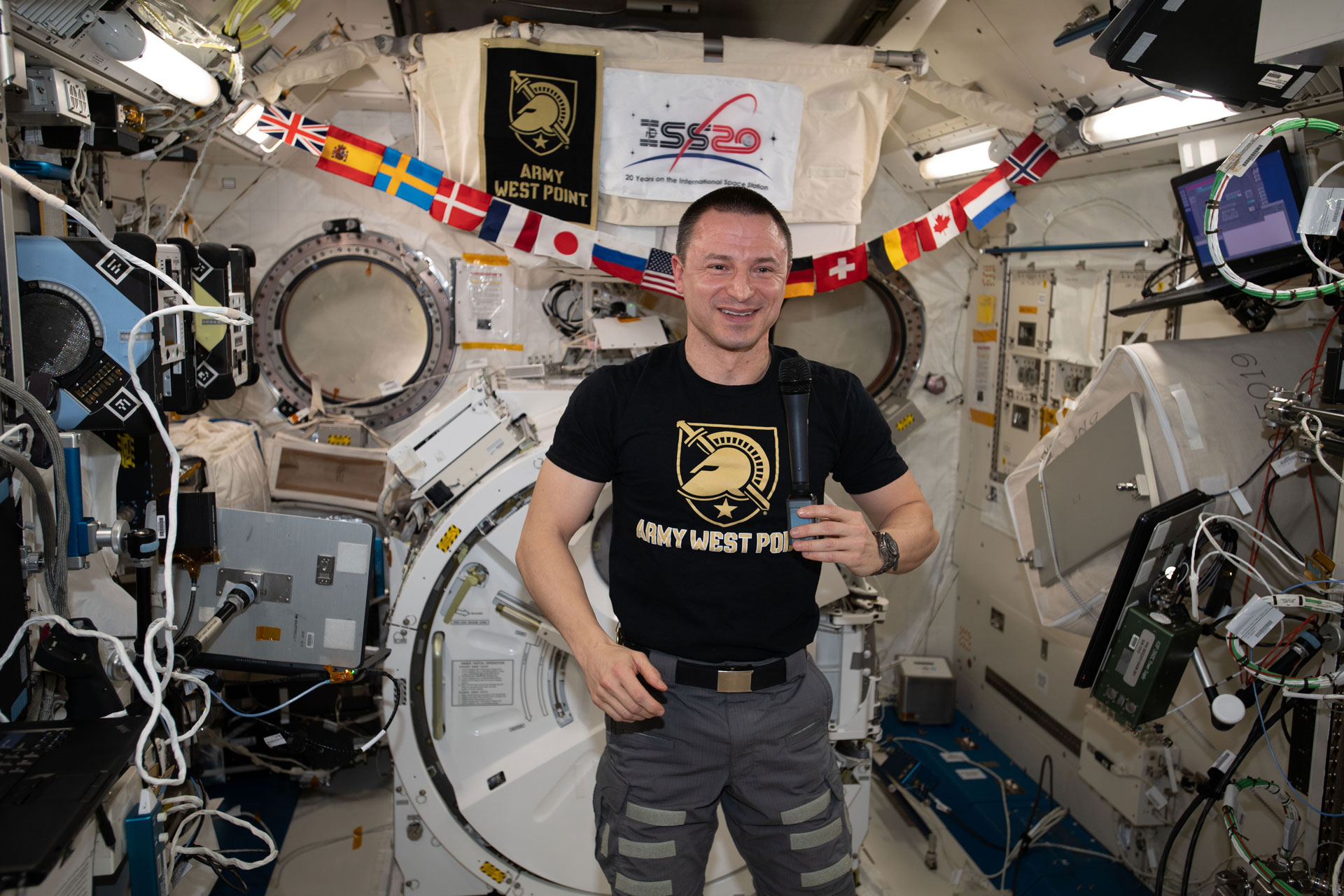
MIC CHECK, 1-2-3: Morgan shows his Army pride in the Kibo laboratory module, while talking to personnel on the ground in March 2020.
“Much like Lt. Col. McClain, I am a Soldier first—both of us believe that very strongly—we’ve both of us made that decision first, to go to West Point and be an officer and become a leader of character,” Morgan said. Many aspects of his background come in handy as an astronaut, but none more than the idea of selfless service. “That’s a fundamental part of being a leader—it’s also very inherent in being a physician, and, as it turns out, it’s also really important in being a good astronaut, to be a good team leader, team player and member of a team,” he said.
“A big part of what makes this mission work at NASA is that everybody contributes,” McClain explained. “But everybody also is ready to step back and take the lead from the person next to them. It’s kind of this constant movement between being a leader and a follower, and you really have to step away from any ego.”
That collaborative attitude is what makes everything work—on the ground, in flight and on the ISS. Much like the overarching acquisition process, space exploration needs all of its metaphorical moving parts to work together as seamlessly as possible to achieve the mission: Shuttles must be designed, bought and tested; flight crews trained; scientific experiments planned for and taught to the crew; ground staff prepared for the mission; and of course—the exciting part for us outside observers—the rocket launch. An untold amount of work goes into that achievement (much like delivering a new piece of equipment to Soldiers) and these collaborations reach global proportions, now more than ever.
“This is an extremely exciting time for space on many levels. We’re seeing that we’re at what’s described as an inflection point here,” Morgan said. The inflection point has three parts: civil space, which is national space programs like in NASA, or the European Space Agency; commercial space, as with SpaceX and Boeing and other companies that “put hardware into low-Earth orbit;” and finally, defense space—specifically, the United States Space Force. “All of these things coming together is great for … space exploration,” he said. “We’re really looking at an exciting decade ahead.”
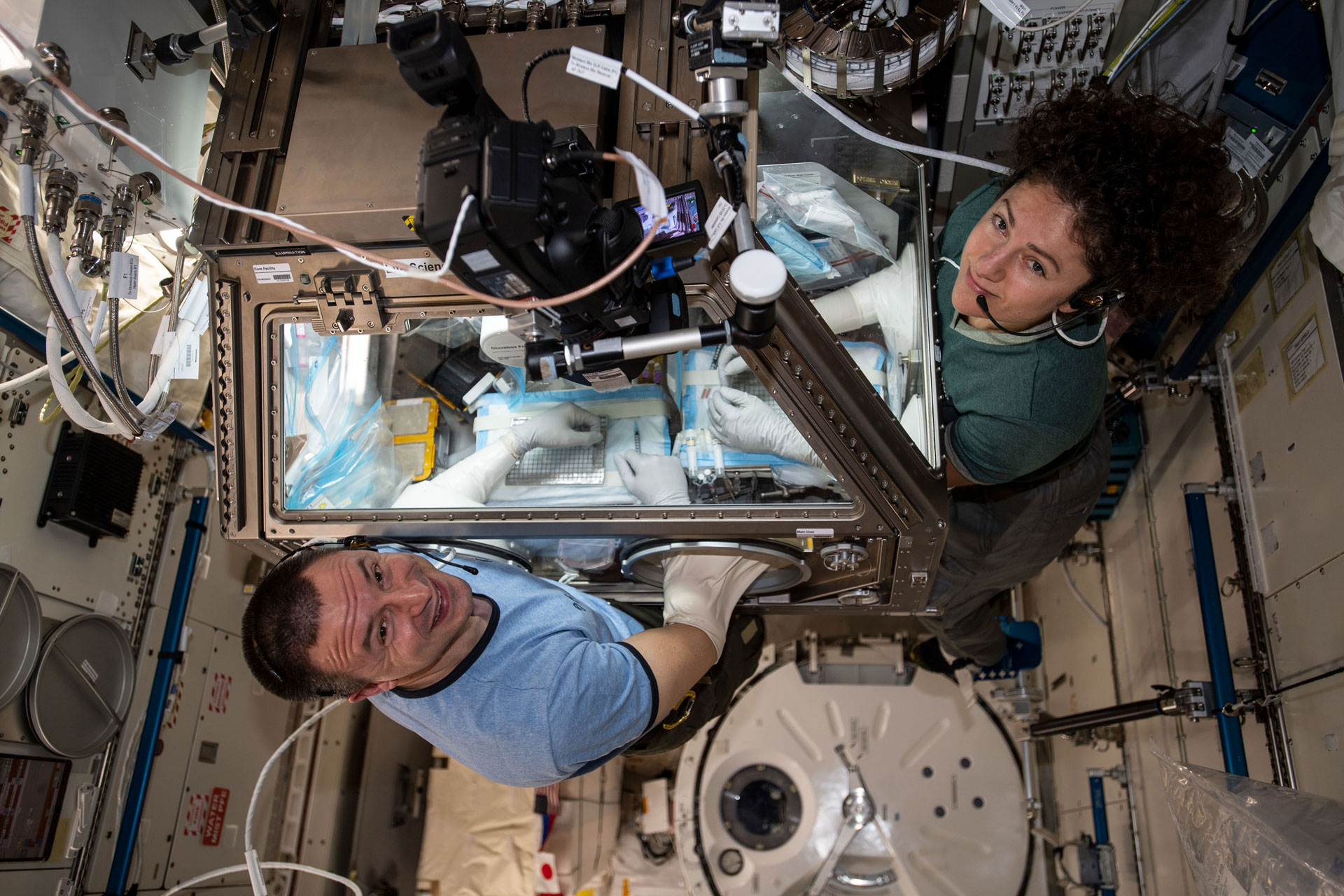
THE GRAVITY OF THE SITUATION: Morgan and NASA astronaut Jessica Meir conduct research operations inside the Japanese Kibo lab module’s Life Sciences Glovebox in November 2019. The Expedition 61 flight engineers were studying mice for the Rodent Research-14 investigation, which observes how microgravity affects the body on a cellular and organ level.
INNOVATION WITH INDUSTRY
“Over the last 50 years, NASA has done a lot of research on rockets … on living in space, on working in space, on satellite repairs, on all these great things,” McClain said. “And now it’s our job to share that with commercial entities within the United States and let them take that research and make it even better, and make it more accessible and do more research than what NASA does in and of itself.” About 10 years ago, NASA wrote contracts for commercial companies to develop space flight systems that would bring astronauts to the ISS, she explained. Boeing and SpaceX were among the businesses that stepped in to fill that need. Now, NASA has completed two manned flights on the SpaceX Dragon vehicle—the most recent on Nov. 14—and Boeing will conduct another unmanned test flight of the Starliner vehicle in the first quarter of 2021, in preparation for crewed flights to the ISS later in the year.
In fact, these partnerships are an integral part of NASA’s plans for the future—not just in transporting astronauts back and forth from the ISS, but also in putting another crew on the moon and exploring deep space. “For the first time in NASA’s history we have astronauts training and trying to fly on four different vehicles,” McClain said—the SpaceX Dragon, the Boeing Starliner, the Orion space craft, and, of course, the Russian Soyuz. NASA is designing and building the Orion in partnership with Lockheed Martin as part of the Space Launch System (SLS) rocket—the most powerful in the world, according to NASA—for deep space exploration as part of the Artemis program.

A NEW ERA: The SpaceX Dragon cargo craft approaches its capture point 10 meters from the ISS in May 2019, with the Canadarm2 robotic arm poised to reach out and grapple the resupply ship. Astronaut David Saint-Jacques would command the Canadarm2 to capture Dragon as astronaut Nick Hague backed him up and monitored systems.
The Artemis program aims to land the first woman and the next man on the moon by 2024 for further exploration of the lunar surface. But, McClain said, “We’re not just going there to put a boot on the moon. We’re going there as part of an international conglomeration of countries to build a sustainable presence on the surface of the moon to learn how to do that for future deep space missions, like to Mars.” NASA is hoping the first crewed mission in the Artemis program will happen in the next couple of years, McClain added—it will be a flight of the Orion on the SLS rocket, out and around the moon, to test all the systems. After that is complete, the next mission will be to put a lunar lander on the moon’s south pole, she said.
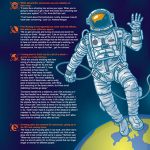
Click on the image to view the Astronaut infographic.pdf
BODIES IN MOTION
Astronauts learn a lot about life on Earth by going to space—and, occasionally, terrestrial life informs behavior in space. Life on board the ISS is a bit like camping, Morgan said—you’re not quite taking a shower, or brushing your teeth at the sink, but rather finding creative ways to wrangle water (and other liquids) in microgravity. Astronauts also have to keep their bones and muscle mass from deteriorating while in space, which they do through regular exercise. Over time, such exercises have nearly eliminated all the bone loss astronauts had previously experienced, McClain said. “We still have some bone loss throughout a mission, but nothing comparted to what we saw in the early days,” she said.
The effects of microgravity on the human body are a significant part of what astronauts are studying while on board the space station. “When we talk about how we’re going to get to Mars, folks really focus on [which] vehicle we’re going to be in, but the other questions that a lot of people are asking is, ‘How is this going to effect the human body?’ ” McClain said. “What’s our body going to be like when we get to Mars and we’re back in a gravity environment? What does that do to us long term?” Right now, it takes just under 24 hours to reach the ISS, and expeditions usually last about six months. In comparison, NASA projects that manned Mars missions will be about three years in duration—so learning how the human body reacts to microgravity and space flight is paramount for success.
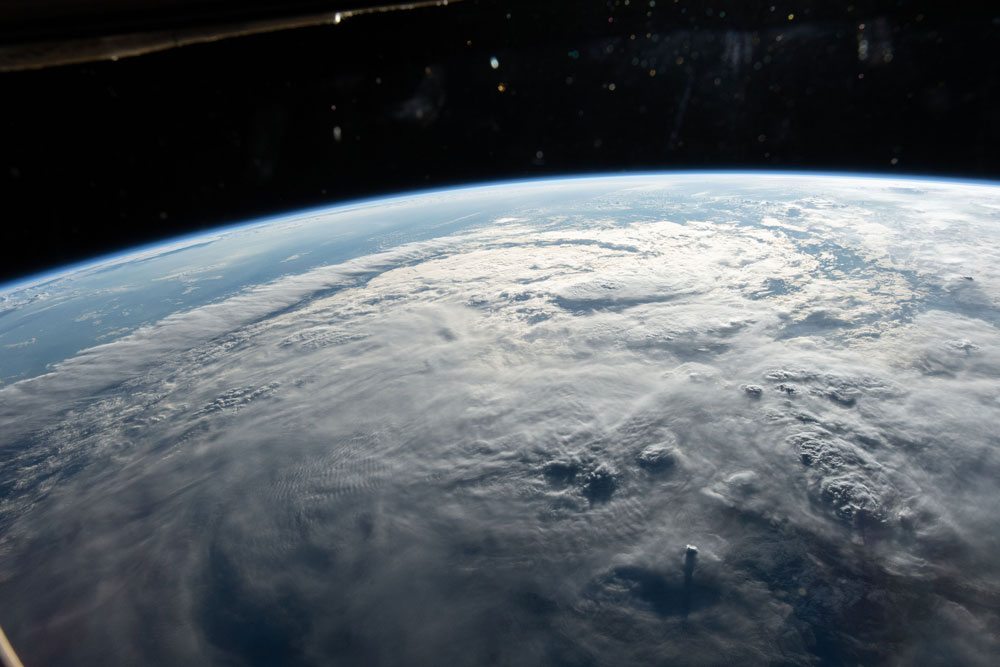
STORMY OUTLOOK: Tropical Cyclone Idai is pictured from the ISS in March 2019 as the orbital complex flew 261 miles above the southeast coast of Africa. Idai’s track took it over the Mozambique Channel and portions of the nations of Madagascar, Mozambique, Malawi and Zimbabwe, creating devastation and casualties in the southeast portion of the African continent.
astronaut_infographic-FullIn 2019, both Morgan and McClain were subjects for an ongoing vascular echo study that took place preflight, while in space and when they returned to Earth. The study charted how the different pressures throughout the body affect the way blood moves and the way the arteries expand and contract with your heartbeat. “[It] looked at [how blood flows], how does our physiology change when living in microgravity for a long period of time, and does that potentially have an impact on our brain and subsequently affect how our vision changes,” Morgan said. “We do see some vision changes in long-duration space flight that we do need to understand.” Morgan was the final subject in that particular study, and the results are currently being analyzed.
The type of science experiments conducted aboard the ISS span a wide range of fields—from physics to engineering to biology, among others. Some of those experiments are contained to one particular mission, while others go on for years, Morgan said.
“There are two broad categories of experiments that are on the ISS,” he explained. “There are those that we interact with directly, and then there are a lot of experiments that are installed after—maybe we install [the experiments] and then they run themselves, or they are on the exterior of the station, and it’s just sort of set it and forget it, we don’t interact with it routinely.” For example, the alpha magnetic spectrometer—a particle physics detector that looks for dark matter, antimatter and missing matter from a module on the outside of the ISS—has been around for the last decade, and it usually works just fine on its own. While Morgan was aboard the space station, the spectrometer was experiencing some trouble with its thermal control pump, and he participated in a spacewalk to correct the problem.
“That’s an example of something where we don’t expect to have to do that, but we’re prepared to in case we need to,” Morgan said. “In terms of the experiments on the inside the station, those are always working closely with the ground team. They put a lot of time and effort in to make sure that it is as simple for us to do in space as possible, so that even though we’re not experts, they make us feel like part of the team and have some expertise.” Of course, Morgan said, they have to be extremely careful when handling these experiments, as years of research have gone into them before they ended up in space.

SURGICAL PRECISION: Morgan is tethered to the ISS while finalizing thermal repairs on the Alpha Magnetic Spectrometer, a dark matter and antimatter detector, during a spacewalk in January 2020 that lasted six hours and 16 minutes. See NASA video featuring Dr. Morgan and his work with bone loss and the alpha magnetic spectrometer: https://www.youtube.com/watch?v=I9f39S9wgB0
“An example of a study that was completed [in the time] I was onboard was just recently published in a journal—I believe it was called the Mighty Mouse study—and that looked at providing a treatment to mice that blocked a pathway that normally inhibits bone and muscle growth,” Morgan said. Blocking the pathway allowed the bones and muscles of the mice to grow larger and denser than usual. “That was very interesting because [that treatment] is something we could potentially see as a countermeasure for the effects of living in space for a long time, but also has information for how we treat muscular, muscle and bone diseases on Earth as well,” he added. The experiment, officially called Rodent Research-19, had its result published in the Proceedings of the National Academy of Sciences of the United States of America in September.
Because the ISS is an international venture, astronauts can’t just while away the days experimenting with scientists in the United States—they also have to navigate international relations. However, being in space provides an interesting perspective for diplomacy, and it isn’t as difficult as you might think.
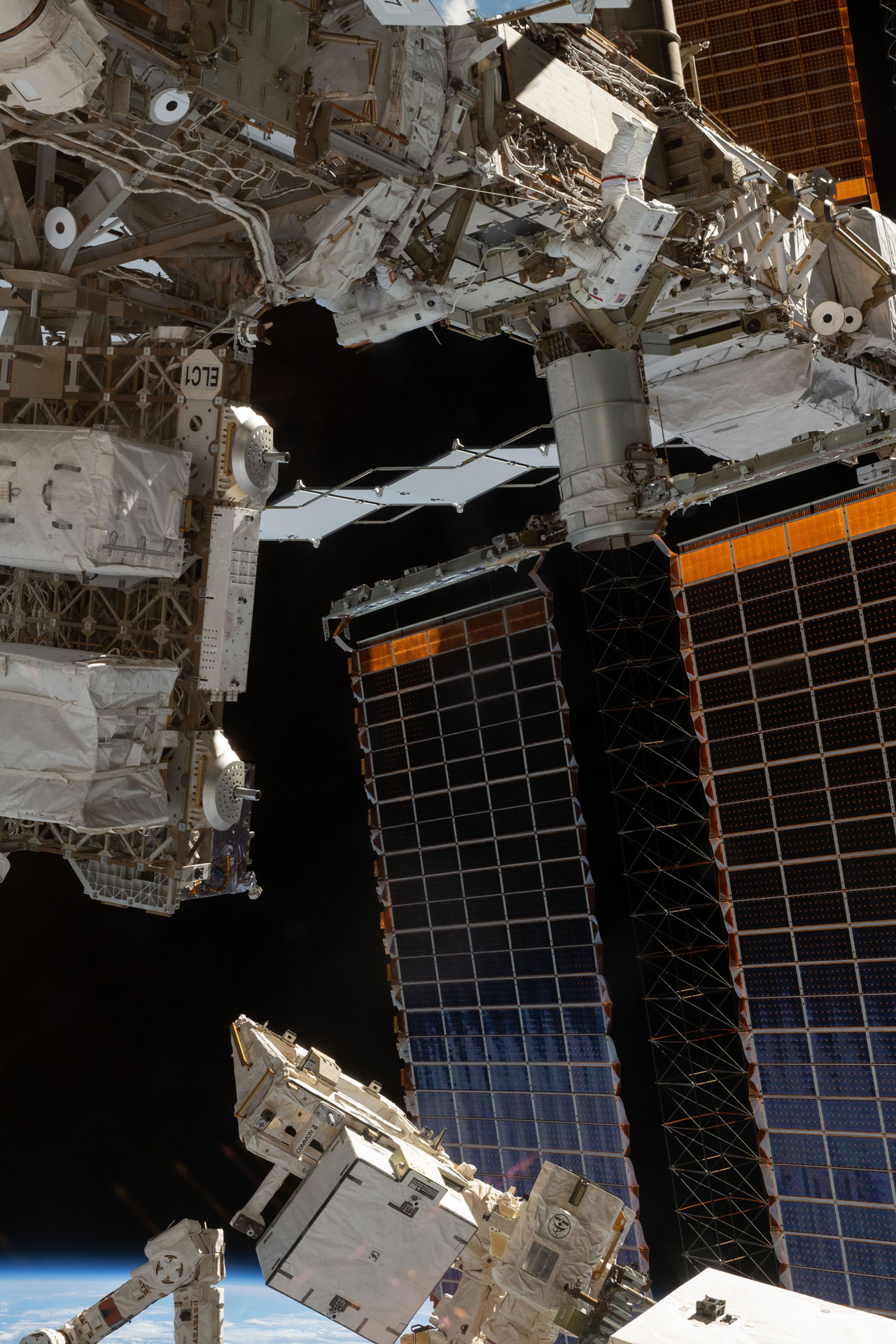
FIRST TIME OUT: McClain, at top in her white U.S. spacesuit with red stripes, is tethered to the ISS’s Port-4 truss structure during a six-hour, 39-minute spacewalk in March 2019 to upgrade the International Space Station’s power storage capacity. This was the first spacewalk for McClain and fellow astronaut Nick Hague (out of frame).
“The international aspect is something that is one of my favorite parts of working on the space station,” McClain said. She emphasized that both she and Morgan flew on the Soyuz spacecraft from Kazakhstan—she in 2019 and he in 2020—and that her own flight crew had Canadian and Russian personnel. When she arrived on the space station, there were three astronauts already on board: German, Russian and American. “Our crews are very international but, interestingly, what I enjoy most about that day to day is that we don’t really think about it,” she said. “We know them on a human level, a person-to-person level. They know us, we know their families, they know our families, and these are our coworkers and our friends all across the world. To me what it’s done is that it has made the world a little bit smaller.”
McClain often likes to flip the question of international politics on its head. Rather than politics informing the relationships of those aboard the ISS, she said the relationships between the crewmates should inform the politics. “I feel a burden, a responsibility to say, to kind of spread that word and say look what we can achieve when we do something together,” she said. “Because this is an amazing feat—the International Space Station is the largest manmade thing out there [in space], and it was put together by all these different countries all around the world. … And we launched parts of it from Russia, from Europe, from Japan, from the U.S., and the first time these components ever touched each other was in space, and it works! And it works well.”
“I think it’s a fantastic legacy of the program that it will be, probably, one of the most important legacies that we take forward with us in the future programs,” Morgan said of the international cooperation aspect.
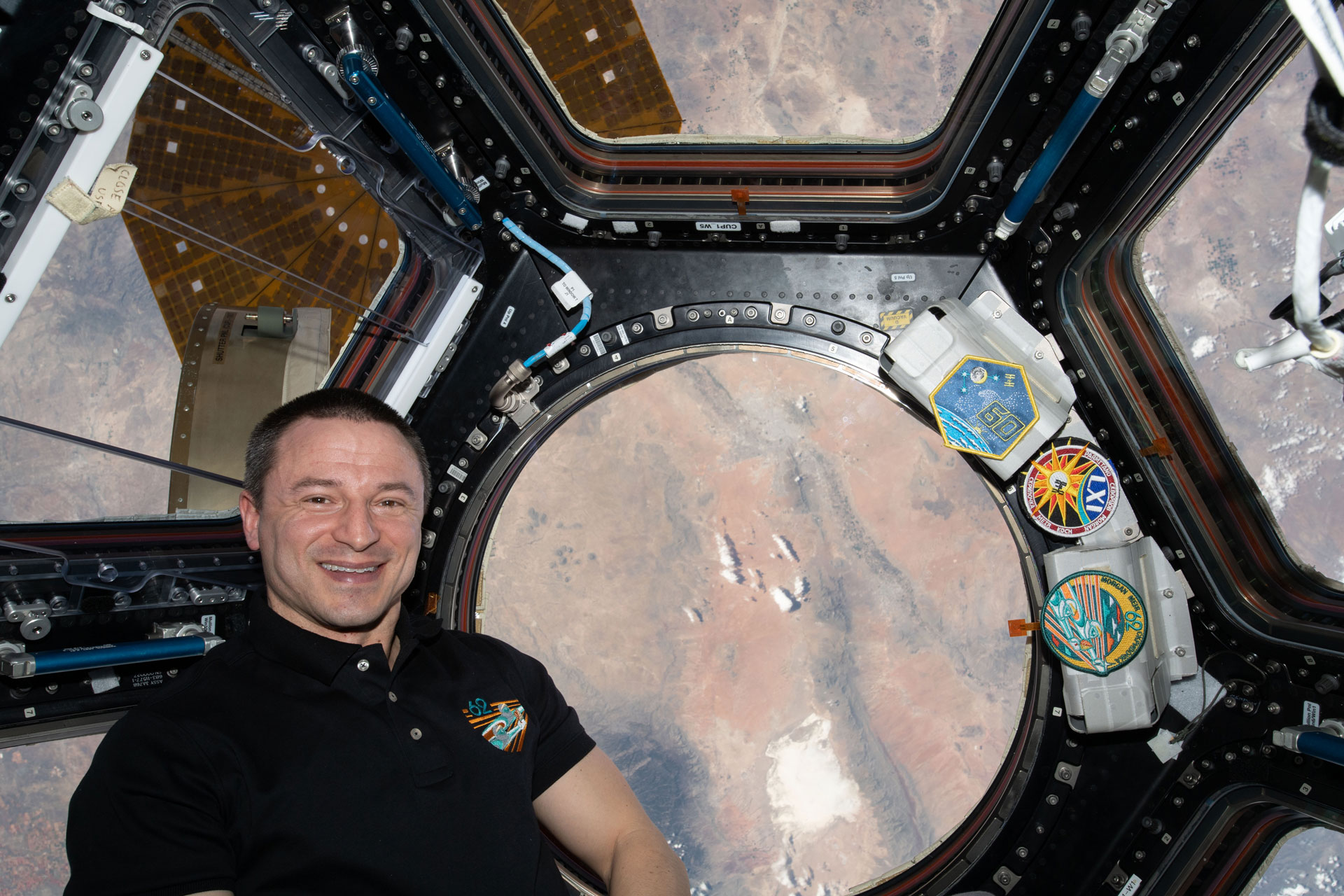
A NEW VIEW OF NEW MEXICO: Morgan, the Expedition 62 flight engineer, inside the ISS’s “window to the world,” the cupola, in April 2020. The orbiting lab was flying above the state of New Mexico.
A UNIQUE PERSPECTIVE
While McClain had returned to Earth well before the COVID-19 pandemic struck, Morgan was still aboard the ISS during the initial wave of the disease. He, and two others from his flight crew, landed back on solid ground in what he thought was the middle of the crisis, but was actually the beginning. “Watching that play out and being the only three people off the planet who were truly protected from the pandemic,” Morgan said, “and then being dropped back down in the middle of it, really helped us reflect about how fragile of a planet we live on, but also how beautiful of a planet that we live on,” The pandemic is an example of something that affects everyone equally, he added. He believes that the collaborative, multinational effort in building and sustaining the ISS for more than two decades illustrates how we, as a global community, can come together to solve problems that affect us all.

FAR OUT PHOTO: McClain takes a break inside the ISS’s cupola while practicing Canadarm2 robotics maneuvers and Cygnus spacecraft capture techniques in April 2019.
“You really do get a different perspective when you’re out on the International Space Station, when you’re off the planet,” McClain said. She recalled one of her spacewalks, holding on to the ISS by a handrail and looking down at the blue and green orb of Earth, which was the biggest thing she could see, other than the ISS. Behind the space station was the infinite expanse of space—the only thing holding her in place was gravity. She realized that “this is the only planet we’re ever going to have, these people that we’re walking the Earth with are the only other people that we’re ever going to have on our planet. We have this common mission of taking care of Spaceship Earth.”
“I think, if everybody could back up and see that … I think it would put a lot of our problems into perspective,” she said.

COSMIC PROPORTIONS: A SpaceX Falcon 9 rocket with the company’s Crew Dragon spacecraft onboard rolls out of the horizontal integration facility at Launch Complex 39A in November 2020 as preparations continue for the Crew-1 mission at NASA’s Kennedy Space Center in Florida.
For more information on NASA astronauts and the Artemis program, go to https://www.nasa.gov/.
JACQUELINE M. HAMES is an editor with Army AL&T magazine. She holds a B.A. in creative writing from Christopher Newport University. She has more than 10 years of experience writing and editing news and feature articles for publication.
Read the full article in the Winter 2021 issue of Army AL&T magazine.
Subscribe to Army AL&T News – the premier online news source for the Army Acquisition Workforce. ![]() Subscribe
Subscribe







